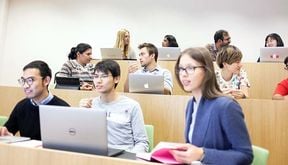Aalto Bachelor's programme in Science and Technology in English to start in 2018

Aalto University will launch a new Aalto Bachelor’s Programme in Science and Technology in English in the autumn of 2018. All Aalto University schools of engineering will be involved in the programme.
In the new programme, all students complete the same basic studies with strong focus on mathematical and computational methods and robust information technology skills. In all schools, the major subjects will be designed with these perspectives in mind.
On the first application round in January 2018, there will be two study options: Data Science at the School of Science, and Digital Systems and Design at the School of Electrical Engineering. The majors to be provided by the School of Chemical Engineering and the School of Engineering will be confirmed during next year.
There may also be plans for additional majors between different schools of engineering. In the first year, 25 students will be admitted per programme, but, in the long run, the goal is to have slightly over 100 new students entering the programme each year.
Top-level experts to the needs of the digital society
Jouko Lampinen, Dean of the School of Science, considers the new Bachelor's programme significant.
‘Digitalisation changes the world faster than any of the earlier industrial revolutions. The impacts of artificial intelligence, data science and automation go deep in every sector, both in technology and economy. Aalto's new BSc Programme in English is a response to this challenge.’
‘We did not build a copy of a conventional Bachelor’s programme in Science and Technology, but the programme is built upon strong mathematical and information technology skills. In their majors, students can continue to go deeper into data science and artificial intelligence or digital systems engineering, which are all fields suffering from serious shortage of top-level experts. The programme will be expanded in the coming years in such a manner that the majors enable specialisation in various fields of technology. The programme complements excellently the contribution Aalto is making as the driver of digital revolution in the Finnish industry and business,’ Jouko Lampinen points out.
Admission based on the student’s previous academic record
The programme will not have any entrance examinations, but all students are selected on the basis of paper selection. There will be two admission groups for the programme:
- The students that have completed the Finnish matriculation examination or the international baccalaureate degree (IB, EB, RP) in Finland are selected on the basis of certificates in accordance with the DIA application procedure*.
- International applicants are required to have completed the SAT test as well as the SAT Subject Test in mathematics.
Application period for the new Aalto Bachelor’s Programme in Science and Technology in English will be 9 – 24 January, 2018.
Admission information will be updated on the Aalto University's Studies website during October.
* The joint application procedure in engineering and architecture
Photo: Aino Huovio
Read more news

Get to know us: Associate Professor Maria Sammalkorpi
Sammalkorpi received her doctorate from Helsinki University of Technology 2004. After her defence, she has worked as a researcher at the Universities of Princeton, Yale and Aalto.
Aalto computer scientists in ICML 2024
Computer scientists in ICML 2024
Getting bacteria into line
Physicists use magnetic fields to manipulate bacterial behaviour